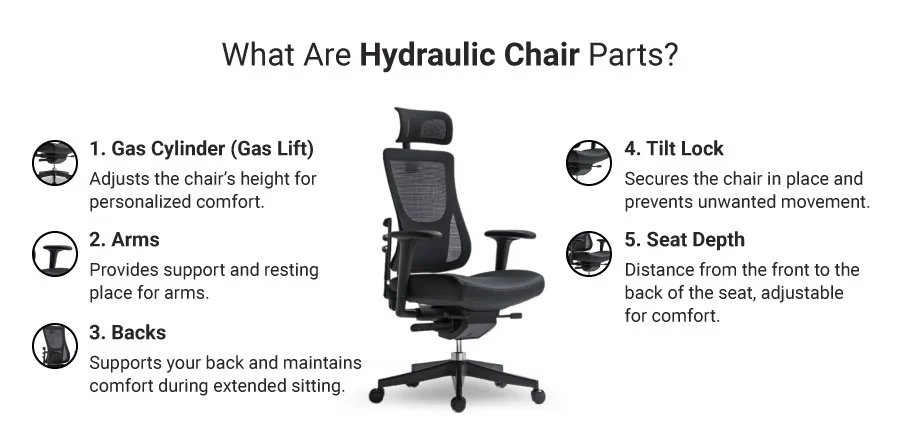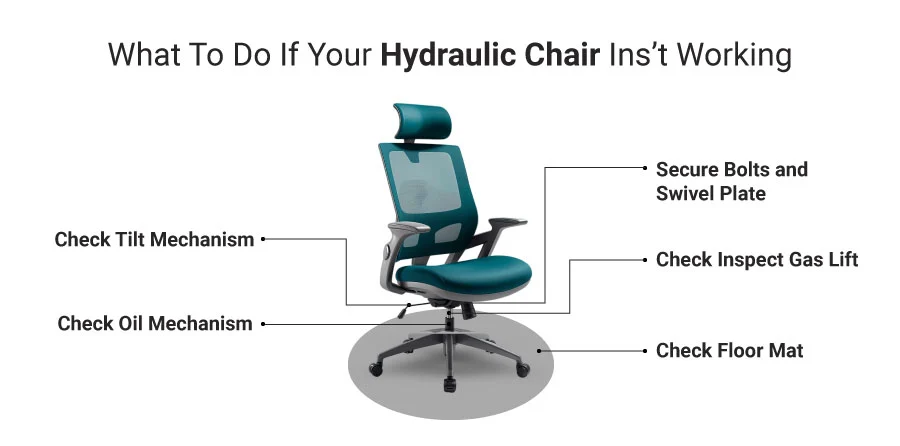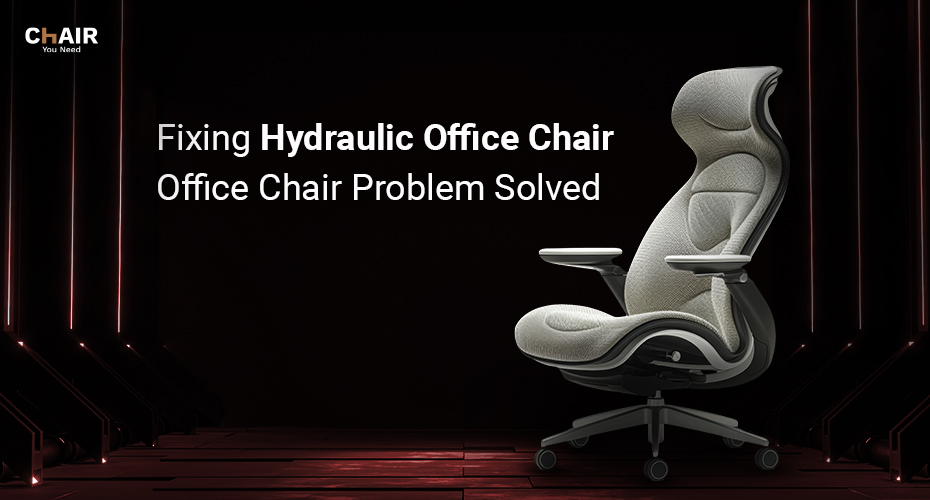You remember the time you sat in this chair and felt like you were being tricked. Though you knew you couldn’t lean back, it leant with you and lowered you down as if it were a magic carpet. A few days later, it gave out: you leaned back, and the chair just kept going, dumping you on the floor.
There is no doubt that a hydraulic chair is the most comfortable office chair on the market. However, as with any piece of furniture, they sometimes have problems.
No worries, though — you can probably fix it yourself. By following these steps, you can repair your hydraulic chair and enjoy smooth, gentle lowering once again.
All About Office Chair Parts
An office chair is a piece of furniture that everyone needs in their workspace. It is comfortable, adjustable, and typically has wheels so that it can be moved around easily. But what exactly makes up an office chair?
The first part of an office chair that we will look at is the base. The base is typically made of metal or plastic and houses the chair’s wheels. It is important to choose a base that is sturdy and will not tip over easily.
The next part of the chair is the seat. The seat is usually upholstered in fabric or leather and should be comfortable to sit in for long periods of time. It is also important to choose a seat that is the right size for you so that you are not cramped up while working.
The backrest is another important part of an office chair. It should be high enough to support your back and prevent you from slouching. It is also important to choose a backrest that is adjustable so that you can find the perfect position for your needs.
The armrests are also important as they provide support for your arms while you are typing or using the mouse. They should be adjustable so that you can find the right height for your needs.
The last part of an office chair that we will look at is the mechanism. The mechanism allows you to adjust the height of the seat and the backrest. It is also important to choose a mechanism that is easy to use so that you do not have to keep fiddling with it while you are trying to work.
What Are Hydraulic Chair Parts?
Hydraulic chair parts are components that help to adjust the seat and back of the chair. These parts include the arms, backs, tilt locks, and seat depth. Each part plays an important role in ensuring the comfort and support of the person sitting in the chair.

Gas cylinder: The cylinder or gas lift is responsible for adjust the height of the chair. This part is important for people who are taller or shorter than average, as it allows them to adjust the chair to their own comfortable height. Such as hbada ergonomic office chair, the height of the hbada ergonomic office chair can be adjusted by a gas lift.
Arms: The arms of the chair help to support the person sitting in the chair. They also provide a place to rest your arms when you are not using them.
Backs: The backs of the chair provide support for your back and help to keep you comfortable while sitting.
Tilt lock: The tilt lock helps to keep the chair in place and prevents it from moving around.
Seat depth: The seat depth is the distance from the front of the seat to the back of the seat. This part is important for people who are taller or shorter than average, as it allows them to adjust the chair to their own comfortable height.
Each of these parts is important for the comfort and support of the person sitting in the chair.
How Does A Hydraulic Chair Work?
Hydraulics are systems that use pressurized liquids to create motion, and they’re all around us. Cars, buses, construction equipment, even garbage trucks all rely on hydraulics for a smooth ride. Hydraulic chairs are no different. But how does it work?
Let’s start with the basics. Hydraulic chairs contain a solid base that contains two cylinders built into the legs of the chair. These cylinders are filled with hydraulic fluid, which is essentially just a very thick oil. The cylinders also contain a piston rod, which is a metal rod that extends from the cylinder upwards through the seat of the chair.
The seat of the chair is attached to the piston rod by a spring or a lever arm. When you sit down in your hydraulic chair, your weight causes the piston rod to compress the fluid in one cylinder while pushing fluid out of the other cylinder and through an extension tube into another cylinder at lower height. This creates an overall downward motion and makes your chair go down smoothly.
What To Do If Your Hydraulic Chair Isn’t Working?
If you have a hydraulic chair in your office, you’ll be relieved to know that it is simple to fix. The most common problems are with the chair’s pneumatic cylinders.

Step 1: First, check to see if the glass floor mat is blocking the mechanism.
If it is, remove it and see if the chair works better.
Step 2: If not, try oiling the mechanism with a light weight oil.
Simple oil change can sometimes help to get it working again. Finally, if all else fails, you may need to replace the hydraulic cylinder.
Step 3: Check that the gas lift isn’t damaged.
This can often result in the chair not lowering all the way. You can check this by removing the seat from the base and looking at the gas cylinder. If there is any damage, you’ll need to replace it.
Step 4: Check the tilt mechanism if it won’t recline or it feels loose.
It may be due to an internal spring that has become disengaged or snapped. To repair this problem, remove the seat cover and check for missing parts or broken springs.
Step 5: If your chair won’t remain up or is stiff when you lift it.
The problem could simply be that one of the bolts used to secure it has come loose, so tighten them. Alternatively, you may need to replace your swivel plate if it’s worn out; this will involve disassembling your chair to get access to it.
Hydraulic office chair with heat and massage has different parts that may need to be checked and repaired from time to time. The most common problems include loose or broken screws, ripped upholstery, and jammed recliner mechanism.
How To Fix Hydraulic Chair?
If you experience pain at the top of your buttock crack when sitting, it is likely due to a problem with your hydraulic office chair. This can be caused by a number of factors, including a faulty or damaged chair, incorrect seating posture, or an underlying medical condition.
1. Measure Your Chair’s Gas Cylinder:
The first thing you need to do is find out how big your chair’s gas cylinder is. You can do this by measuring the diameter of the cylinder itself or, if you have the chair’s model number, checking online for the specifications.
2. Find a Replacement Cylinder:
Once you know the size of your gas cylinder, you can start shopping for a replacement. You can find replacement gas cylinders at most office supply stores or online.
3. Install the New Cylinder:
Installing a new gas cylinder is relatively simple. First, remove the old cylinder from the chair by unscrewing it from the base. Next, screw the new cylinder into place and replace any covers or caps that were on the old cylinder. Finally, test out the new cylinder by sitting in the chair and raising and lowering the seat.
4. Tighten the Locking Ring:
If your chair has a locking ring, you may need to tighten it after installing the new gas cylinder. The locking ring is usually located at the top of the cylinder and can be tightened with a wrench.
Alternative Method:
5. Hose Clamp Method:
If you can’t find a replacement gas cylinder that fits your chair, you can try the hose clamp method.
- First, remove the old gas cylinder from the chair.
- Next, find a hose that is the same diameter as the cylinder and cut it to the same length as the cylinder.
- Wrap the hose around the cylinder and secure it in place with a hose clamp.
- Finally, screw the cylinder back into the chair and test it out.
Can you fix the hydraulics in an office chair?
It is possible to fix the hydraulics in an office chair, but it may be difficult to do so depending on the severity of the issue. If the problem is minor, you may be able to fix it yourself by replacing a part or adding more oil to the system. However, if the problem is more serious, you may need to hire a professional to fix it for you.
How do I fix the tilt mechanism on my office chair?
If you have an office chair with a tilt mechanism that isn’t working properly, there are a few things you can do to fix it. First, check the tension of the tilt mechanism. If it’s too loose, the chair will rock back and forth instead of tilting smoothly. To adjust the tension, find the knob or lever on the chair that controls the tilt tension and turn it until the chair tilts the way you want it to.
If the tension is already set properly but the chair still isn’t tilting smoothly, the problem may be with the seat itself. Try sitting in the chair and rocking back and forth a few times to see if that loosens things up. If not, you may need to disassemble the chair and check the seat pivot point for any damage or wear.
Which one is better steelcase leap vs gesture?
If you’re looking for a hydraulic office chair, you have two main options: the steelcase leap and the gesture. Both are great chairs that will provide you with a comfortable seating experience.
The steelcase leap is a great option if you’re looking for a comfortable, adjustable chair. It features a steel frame that is both durable and supportive. The gesture, on the other hand, is a great choice if you’re looking for a chair that is both comfortable and stylish. It features a leather upholstery that is both comfortable and stylish.
Conclusion:
The problem with repairing hydraulic office chairs is their complexity and their variety. From the design to the assembly, every hydraulic office chair is different. They also are all designed for a different use or for a specific type of user.

